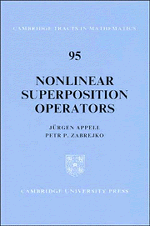Book contents
- Frontmatter
- Contents
- Preface
- Chapter 1 The superposition operator in the space S
- Chapter 2 The superposition operator in ideal spaces
- Chapter 3 The superposition operator in Lebesgue spaces
- Chapter 4 The superposition operator in Orlicz spaces
- Chapter 5 The superposition operator in symmetric spaces
- Chapter 6 The superposition operator in the spaces C and BV
- Chapter 7 The superposition operator in Hölder spaces
- Chapter 8 The superposition operator in spaces of smooth functions
- Chapter 9 The superposition operator in Sobolev spaces
- Bibliography
- List of Symbols
- Subject Index
Chapter 6 - The superposition operator in the spaces C and BV
Published online by Cambridge University Press: 05 February 2012
- Frontmatter
- Contents
- Preface
- Chapter 1 The superposition operator in the space S
- Chapter 2 The superposition operator in ideal spaces
- Chapter 3 The superposition operator in Lebesgue spaces
- Chapter 4 The superposition operator in Orlicz spaces
- Chapter 5 The superposition operator in symmetric spaces
- Chapter 6 The superposition operator in the spaces C and BV
- Chapter 7 The superposition operator in Hölder spaces
- Chapter 8 The superposition operator in spaces of smooth functions
- Chapter 9 The superposition operator in Sobolev spaces
- Bibliography
- List of Symbols
- Subject Index
Summary
Apart from the space S = S(Ω), which was studied in detail in Chapter 1, the space C = C(Ω) of all continuous functions on a complete metric space Ω plays an important role in both linear and nonlinear analysis. If Ω is a compact subset of Euclidean space without isolated points, most results on the superposition operator in C(Ω) are of course well-known “folklore”. For instance, in this case F maps C into itself if and only if f is continuous on Ω × ℝ, and F is always bounded and continuous. A somewhat more careful analysis is required, however, if Ω, has isolated points.
Before studying the superposition operator in the space C, we discuss a certain continuity property “up to small sets” of functions f = f(s, u) which is usually called the Scorza–Dragoni property. It turns out that the functions having this property are precisely the Carathéodory functions.
The main sections of this chapter are devoted to the study of the superposition operator from C into C, from C into S, and from S into C. Since C is a thick set in S, there is no essential difference between the cases F(S) ⊆ S and F(C) ⊆ S. On the other hand, the requirement that F(S) ⊆ C leads to a strong degeneracy, as will be shown at the end of Section 6.4.
- Type
- Chapter
- Information
- Nonlinear Superposition Operators , pp. 163 - 180Publisher: Cambridge University PressPrint publication year: 1990

